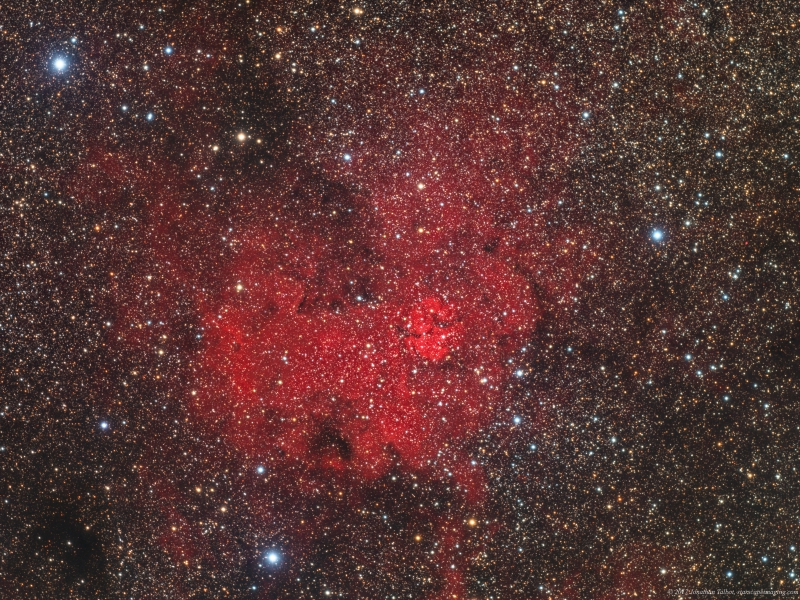
Larger size jpg images available here: 1920X1440 Full size: full size
Sharpless 124
About this object
Sharpless 124 is a emission nebula in the constellation Cygnus the swan. There isn’t much literature out there about this object but the brightest center area looks a lot like the Cocoon nebula but surrounded by fainter red emission. This image was taken from my home observatory in Ocean Springs, MS from July 31st through October 5th 2017. It combines data from Red, Green and Blue filters along with Hydrogen Alpha. Approximately 31hrs and 50min was spent imaging this area of the sky. The raw image resolution is 3.26 arcsec/pixel.
Sharpless 124 is a emission nebula in the constellation Cygnus the swan. There isn’t much literature out there about this object but the brightest center area looks a lot like the Cocoon nebula but surrounded by fainter red emission. This image was taken from my home observatory in Ocean Springs, MS from July 31st through October 5th 2017. It combines data from Red, Green and Blue filters along with Hydrogen Alpha. Approximately 31hrs and 50min was spent imaging this area of the sky. The raw image resolution is 3.26 arcsec/pixel.
Processing Steps:
This image was processing with PixInsight 1.8
Calibration: The batch preprocessing script was used to reduce and cosmetically correct the images and the corrected images were run through the blink tool to weed out the obviously bad images affected by clouds and then run through the subframe selector script to select the best subframes for further processing.
Registration and Integration: The selected images were then registered against a master using the registration tool and combined into master Red, Green, Blue and Ha images using the image integration tool. Drizzle data was also output and the Drizzle tool was used to create the final RGB and Ha master frames. This effectively doubled the resolution to near 1.6 arcsec/pix.
The master frames were gradient corrected using the DBE tool and a RGB image was produced using the channel combination tool. The RGB image was run through the photometric calibration tool to correct the colors.
The RGB and Ha images were then combined using the NBRGB combination script using default values. The output HaRGB image was background neutralized using the background neutralization tool.
Noise reduction: Noise reduction was then performed on the linear image using the multi scale linear transform tool after which the image was stretched using the histogram tool. A second round of noise reduction was done on the stretched image using the TGV noise reduction tool using a mask to protect the bright high signal areas and stars.
Contrast enhancement: The local histogram equalization tool was used with a mask protecting the background and stars to enhance the contrast of the nebula.
Sharpening: The multi scale linear transform tool was used with a mask to slightly sharpen the brighter parts of the nebula.
Star reduction: A star mask was produced and used with the morphological transform tool to slightly reduce the contribution of the stars allowing the nebula to be a bit more prominent.
Several iterations of curves were used with the star mask in place to increase the star color saturation.
Background enhancement: The background enhancement scrip was then used to enhance the faint signal areas and nebula a bit more along with the histogram tool to reset the black point.
A final slight enhancement to the darker areas of the nebula was done using the dark structure enhancement script.
This image was processing with PixInsight 1.8
Calibration: The batch preprocessing script was used to reduce and cosmetically correct the images and the corrected images were run through the blink tool to weed out the obviously bad images affected by clouds and then run through the subframe selector script to select the best subframes for further processing.
Registration and Integration: The selected images were then registered against a master using the registration tool and combined into master Red, Green, Blue and Ha images using the image integration tool. Drizzle data was also output and the Drizzle tool was used to create the final RGB and Ha master frames. This effectively doubled the resolution to near 1.6 arcsec/pix.
The master frames were gradient corrected using the DBE tool and a RGB image was produced using the channel combination tool. The RGB image was run through the photometric calibration tool to correct the colors.
The RGB and Ha images were then combined using the NBRGB combination script using default values. The output HaRGB image was background neutralized using the background neutralization tool.
Noise reduction: Noise reduction was then performed on the linear image using the multi scale linear transform tool after which the image was stretched using the histogram tool. A second round of noise reduction was done on the stretched image using the TGV noise reduction tool using a mask to protect the bright high signal areas and stars.
Contrast enhancement: The local histogram equalization tool was used with a mask protecting the background and stars to enhance the contrast of the nebula.
Sharpening: The multi scale linear transform tool was used with a mask to slightly sharpen the brighter parts of the nebula.
Star reduction: A star mask was produced and used with the morphological transform tool to slightly reduce the contribution of the stars allowing the nebula to be a bit more prominent.
Several iterations of curves were used with the star mask in place to increase the star color saturation.
Background enhancement: The background enhancement scrip was then used to enhance the faint signal areas and nebula a bit more along with the histogram tool to reset the black point.
A final slight enhancement to the darker areas of the nebula was done using the dark structure enhancement script.
Image Details
- Optics : Stellarvue SV 70T triplet refractor
- Mount: Paramount MYT
- Camera: QSI 583
- Filters: Astrodon RGB and 5nm Ha filter
- Exposure: HaRGB: 1080:300:280:250 bin 1x1
- Camera/Mount Control: The Sky X, CCD Auto Pilot 5
- Guiding: Unguided using ProTrack
- Processing: PixInsight 1.8,
- Location: Stark Bayou Observatory, Ocean Springs, MS
- Date: July-Oct 2017




